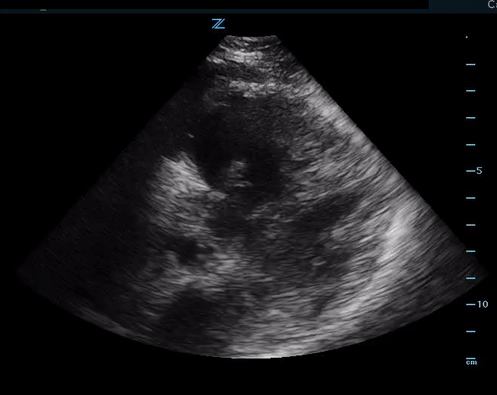65F shortness of breath
65 yo female hx of prior breast cancer with lung mass presents with shortness of breath for the past week, vague right sided chest pain, dyspnea on exertion.
On arrival noted to be in significant respiratory distress with tachycardia, hypoxia, and hypotension. Patient unable to get CT scan as she becomes apneic when laying flat.
Echo shows the following:
Whats that in the right ventricle?
it’s a clot in transit!
First, these are some great images! Note how large the right side of the heart is as well as the septal bowing in both systole and diastole, indicative of pressure overload. Second, while this is a pretty obvious diagnosis once you see the ultrasound, there are still a few learning points we can highlight here.
1) Clot in transit is a rare but not uncommon manifestation of PE, occurring in between 3-18% of patients with clots.
2) Finding of a clot in transient increases mortality related to PE by up to 45% compared to PE alone, likely due to imminent risk of embolization to the pulmonary arteries leading to obstructive shock and cardiac arrest.
3) Data is limited but studies suggest mortality is higher in patients with clot in transit who are treated with anticoagulation alone (36.4%) compared with those who are treated with thrombolysis (18.2%) or surgical embolectomy (18%) (p=0.03, Burgos 2018). Although TPA is an appropriate option, it is still worth touching base with IR here to see if they are willing to do embolectomy.
4) RHS is not the only PE related finding we can see on TTE, however clot in transit is almost always associated with significant RHS. While overall management is similar to other patients with massive PEs, remember this patients have high risk of sudden and severe decline.
In this case, IR declined interventions, agreed with giving tPA. Pt was also started on HFNC for increased work of breathing with vasopressors for blood pressure support, and transferred to the ICU. After patient’s symptoms improved she was able to get CT which showed massive bilateral PE with RLL infarct. She was started on lovenox with plan for transition to a DOAC and discharge tomorrow after 4 days of admission.
REFERENCES:
Burgos LM, Costabel JP, Brito VG, Sigal A, Maymo D, Iribarren A, Trivi M. Floating right heart thrombi: A pooled analysis of cases reported over the past 10 years. Am J Emerg Med. 2018 Jun; 36(6): 911-915.
Chartier L, Béra J, Delomez M, et al. Free-floating thrombi in the right heart: diagnosis, management, and prognostic indexes in 38 consecutive patients. Circulation. 1999;99(21):2779-83.



